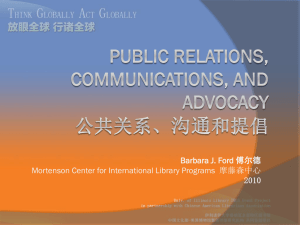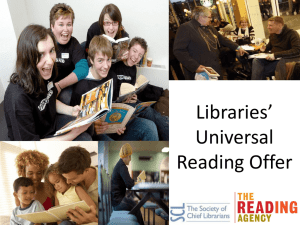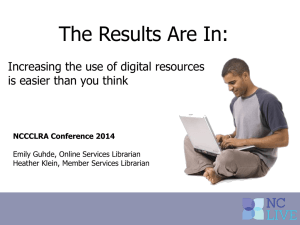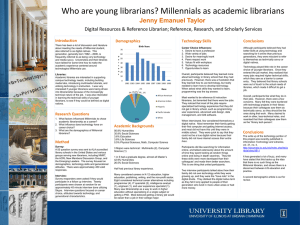LIBRARY SERVICES AND USER NEEDs WITH REFERENCE TO
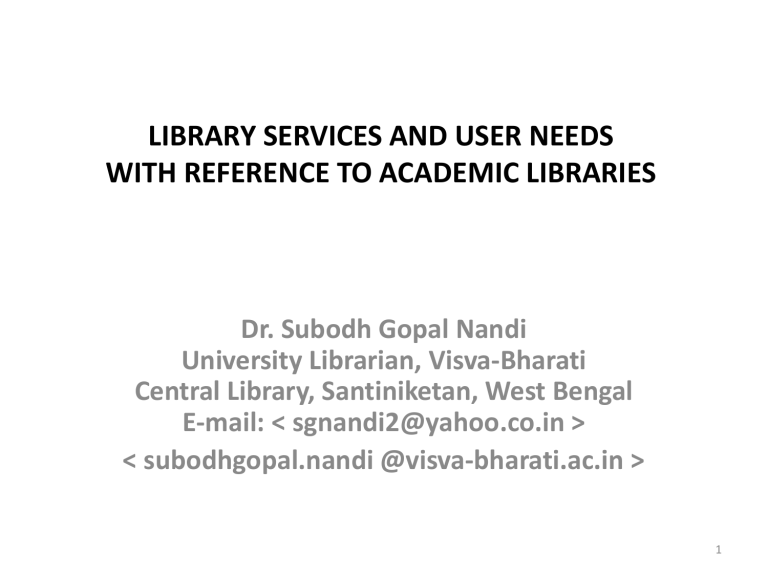
LIBRARY SERVICES AND USER NEEDS
WITH REFERENCE TO ACADEMIC LIBRARIES
Dr. Subodh Gopal Nandi
University Librarian, Visva-Bharati
Central Library, Santiniketan, West Bengal
E-mail: < sgnandi2@yahoo.co.in >
< subodhgopal.nandi @visva-bharati.ac.in >
1
The Library
• ‘Library’ is an establishment or public institution; it has a building, room, or set of rooms; contains collection of books and other documents; takes care of its collection; makes arrangement to access documents who require to use them.
• The library serves for the public or members of the society.
• So, library has five components: a) physical space; b) collection of materials; c) maintenance of collection; d) user group; and e) provision of accessibility.
2
Model - : Library and its basic components
3
Library Clientele
• In past days treasures of knowledge remained hidden from the masses, stored under tight security and accessible only to privileged class people, viz. monks and their disciple, kings and their courtiers, riches, profound scholars, etc.
• Establishment of academic institutions opened the door of library to large scale of people, viz. general students, teachers, scholars and other privileged class of people.
• Library for general public has been established only before 150 years.
4
Library Influenced by Clientele
• In any country, the development of library has depended on the advancement of social processes
• Library developed & improved to satisfy the needs of the users.
• Libraries are not only repositories of knowledge but also dispensers of such knowledge.
• If libraries are ignored, the study as a whole will suffer, because teaching and research are mostly depend upon the qualitative and quantitative service rendered by the libraries.
• Students, teachers and researchers much depend on their library.
5
University Education Commission, India
• The committee was constituted under the chairmanship of
Dr. Sarvapalli Radhakrishnan in 1948-49 and its report was published in 1950.
• It reports that the library is the heart of university’s all works, and as regards to its educational and research work, university derives its life from library.
• Scientific research needs the library as well as its laboratories while for humanistic research the library is both library and the laboratory in one.
•
Both for humanistic and scientific studies, a first class library is essential in a university.
6
Targeted objectives of university libraries to serve its clientele
• To give continuing support to the teaching and learning programme and provide impetus to educational change;
• To ensure maximum access to the widest possible range of resources and services;
• To equip students with basic skills to obtain and use wide range of resources and services;
• To lead them (students) towards a lifetime use of libraries for recreation, information and continuing education.
7
Users’ Need & Expectation
Library users need to search:
• the physical library catalog, including incomplete or under process materials, circulation records, etc.
• holding records of local, nearby & distant libraries.
• bibliographies of paper items, on microform, or on-line items.
• numeric data in social, technical, economic, and scientific databases.
• directories and reference works.
• images and moving images.
• the texts itself.
• full-text that remains in on-line and not physically in library.
• use library with comfort as corporate house provided to its customers.
• convenient use of needed datasets and having copy of them.
8
WWW thrown challenge to Library
• Libraries are now facing competition from Internet and the World Wide Web.
• Students, teachers and other users of the library try to get information through the Internet first, and then they are coming to library for detail checking of required information.
• If they satisfy with the first information, they may not come to library physically.
• So libraries and the librarians need to develop plans how to face the new competition and to remain active to provide library services to the new generation users.
9
Library vs. WWW: The Real Situation
• People want to take advantages of online world, but not at the expense of the physical materials.
• Web-searching is not the only solution to have the knowledge but verification is urgent.
• People recognize the value of shared, communal spaces where they can work by themselves.
• Libraries are currently capable of creating and maintaining value added information.
• People wants to come to physical library that serves as symbols of certain shared, trusted and sacred values.
10
Library vs. WWW: Librarians’ Initiative
• Library supplies information to its users long before;
• To meet present users’ needs librarians have to adopt computer technology for library operation.
• Librarians should have idea of hardware & software that may keep current for a long period of time.
• Library and librarian should always be supported by the higher authority, as they are trying to provide best services for the institutional beneficiaries.
• Fund provision for upgrading software, hardware & workstations which is require to keep the library as a perfect system and successful organization.
11
Academic libraries & their daily functioning and extending services
• Traditional libraries mostly depends on indexing & cataloguing.
• In new environment librarians are always attempted to reach all its users and to serve better way to the users.
• Due to fast development of IT and its application to libraries new styles are adopting by academic libraries for their daily functioning.
• Academic libraries are extending services to its end users, but It is difficult to serve library users' needs because the sources of information are too complex, so extensive and so varied.
12
Academic Library Service Strategies
• Change becomes a way of life for library & information field
• But the core functions of libraries – providing an organized collection of materials and providing assistance in using those materials – remain the same, how libraries fulfill those functions is being transformed
• Technological advances make it possible for libraries to provide access to a wide range of materials that no single library owns
• Libraries can serve customers from around the world as early as they serve the patorns who enter their buildings
• Improved academic library environment is beyond sole control of librarians. It would be joint venture of librarians, library planners, professional bodies, NGO and Government
13
To Develop Academic Library Services
• In new environment due to increasing complexity user's expertise are needed;
• To improve the users’ expertise academic libraries should accept the following:
• User education.
• Advice.
• Simplification.
• Mediation.
• Delegation.
• It makes the library system itself smarter, more capable of determining what should be done next, and thus increases the expertise of library users.
14
L
ibrary Services for the users
• Librarians always attempt to reach all its users by providing the following services:
• Assistance services
• Instruction services
• Referral services
15
Assistance services
• To help users, to identify & locate needed materials.
• Many materials, bibliographic tools are complex to use, and needs interpretation for using such tools.
• Machine-readable data bases are searched on-line; and CD-
ROMs inside library. But using systems are different and librarians provide required assistance.
• Library should develop an environment where users can intuit that they are in a hub, which can expose plenty intellectual and informational resources.
• It is in the place of convergence, where users set them apart from other information providers
16
Instruction services
• Libraries using instruction "orientation", a guided tour, to familiarize students with layout of library building and location of various resources and services.
• Library instructions "point-of-use", indicating use of bibliographic tools, indexing and abstracting services; video-tape, audio tape, and slide-tape presentations.
• It integrates students’ class educational experience and library as gateway of information resources.
• Students interact with information resources as directed by faculty to complete their assignments.
• Students study with peer and extend their knowledge in self-directed ways.
• Learning in library, makes changes in students’ lives.
17
Referral services
• This service refers one user to another library, more specialized library, librarian, or other experts.
• It is referring a library user to another more appropriate resource centre.
• Library use and bibliographic research are complex and becoming more so.
• So, it is necessary to know to whom or to where a referral can be made with a reasonable chance of success.
• The development of detailed knowledge of resources is necessary for referral to work effectively.
• A greater investment in user education will be needed to ensure that effective use is made of library resources, including the resources of all cooperating libraries.
18
19
The Impact of the Model
• The model helps the librarian to develop procedure to serve clientele to meet their demand or need. It also helps librarian:
• To attract new library clientele;
• To increase public faith through out the university organization, so that higher authority allocate more fund for procuring resources, tools, equipments and other technological support for catering qualitative and higher level library services for the clientele;
• To motivate library management group and other library staff individually or group to strive to meet the expectations of library clientele;
• To take risk over some uncertainty, e.g. continued supply of fund, technological fault, permanence of hardware and software, etc.
• To overcome the uncertainty to handle new technology, hardware, software, connectivity, etc.
Conclusion
• A greater emphasis in user education is needed, which ensure the effective use of Paper, Automated, and
Electronic Libraries.
• Technological advancement empowers libraries to offer improved customer-driven service opportunities in physical library or crossing the physical library over the globe.
• Librarians of the academic libraries have to involve continuously in library development processes, and to keep pace with the changing needs of their users.
• This will help academic librarians to adopt new things to the library, that keep service offerings fresh to the academic community.
21
Thank you all
22


